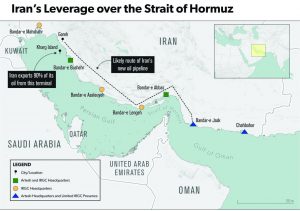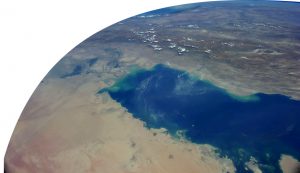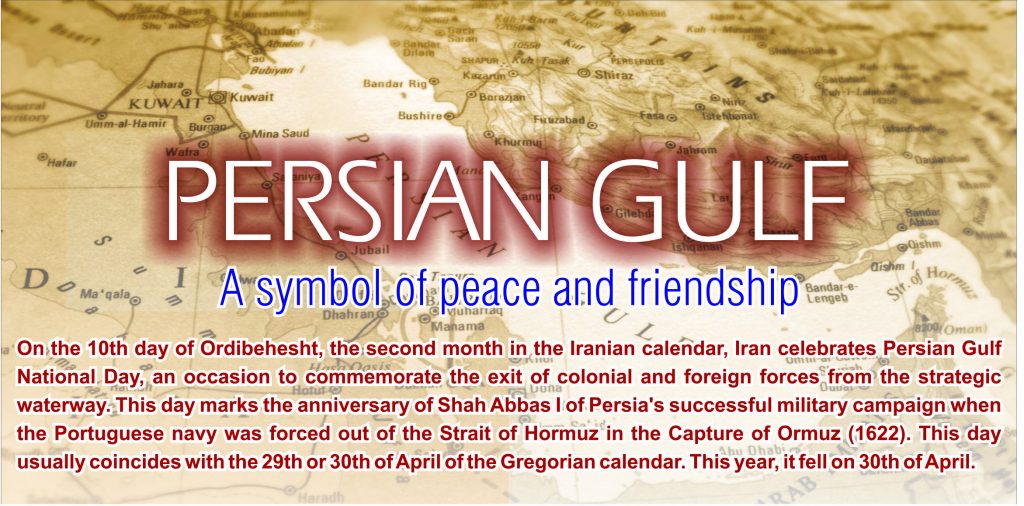PERSIAN GULF
A symbol of peace and friendship
The historical, geographical and commercial position of the Persian Gulf, a place for all living civilizations to live and interact, makes it special to celebrate a day for; a day for all the Iranians to have a short opportunity to defend the historical and authentic truth of the Persian Gulf. This day is the anniversary of forcing out, by Shah Abas I, the Portuguese navy of the Strait of Hormuz in the Capture of Ormuz in 1622.
Having an area of about 241,000 square kilometers – its length is some 990 km, and its width varies from a maximum of about 340 km to a minimum of 55 km in the Strait of Hormuz – the Persian Gulf is a valuable treasure, containing half of the world’s oil reserves, with a unique geographical location that profiteers are always plotting to dominate this regional and global economic highway.
Geographical position and naming issue
The Persian Gulf is the name of an important waterway in West Asia and the Middle East, located along the Sea of Oman between Iran and the Arabian Peninsula. It is bounded by the Shatt al-Arab waterway in the north, which forms the frontier between Iran and Iraq. It runs east through the Strait of Hormuz and the Sea of Oman to the Indian Ocean and the Arabian Sea, and west to the Arvand River Delta, which joins the Tigris and Euphrates rivers and joins the Karun River.
It shares boundaries with littoral states Iran (Persia), Oman, Iraq, Kuwait, Saudi Arabia, Bahrain, Qatar and the United Arab Emirates. The Strait of Hormuz connects the Persian Gulf to the Gulf of Oman. The Persian Gulf is mostly shallow and has many islands, of which Bahrain is the largest.
The Persian Gulf is also important as an international trade route connecting the Middle East to Africa, India and China. It has historically been an integrated region characterized by constant interchange of people, commerce and religious movements.
History
The modern strategic importance of the Persian Gulf dates from the mid-19th century when three great empires confronted each other there: British India, Tsarist Russia and Ottoman Turkey. The British established political control over much of the Persian Gulf in the early 1800s and kept it for 150 years, establishing a tradition of outside involvement that persists today. Britain did not establish formal protectorates (as in the case, for example, of Egypt), but did enter into treaties with local sheikhs offering them protection in return for control over their foreign policy. In 1899, Kuwait, then considered a dependency of the Ottomans, was brought into this system.
Until the discovery of oil in Iran in 1908, the Persian Gulf area was important mainly for fishing, pearling, sailcloth making, camel breeding and date growing.
Since World War II, the Persian Gulf and the surrounding countries have come to account for a significant proportion of the world’s oil production. In addition, the area has approximately two-thirds of the world’s proven oil reserves and one-third of the world’s proven natural gas reserves. The region, thus, has acquired considerable strategic significance for the world’s industrialized countries. Oil pollution, extraction and transportation caused the Persian Gulf to struggle with environmental issues. Out of 21 largest oil spills in the world, 7 cases occurred in this water body, which is threatening the aquatic ecosystem.
Natural resources
The Persian Gulf is a semi-closed basin with world’s largest oil reserves and the largest commuter route for oil tankers. It has its own environmental characteristics, as it is a semi-closed sea, aging 15,000 years, with an average depth of 35 metres, while being high salty with severe heat fluctuations, and an annual evaporation rate of 140 cm.
There are 2 species of dolphin and whale in the area, in addition to 1,100 species of fish and 5 species of turtle, the Persian Gulf is also host to the second largest population of manatees, and 232 seaweed species and 4 million migratory birds annually, but today 240 important species and many habitats are under threat.
Mangrove forests and coral reefs of the Persian Gulf are one of the most biodiverse habitats but they, too, are under serious threat. Oil pollution, countless ships and fishing nets floating on the sea, on the one hand, the construction of artificial islands in the surrounding countries and, most destructively, the presence of 90 percent of the world’s desalination plants in the region, on the other hand, has created an ecosystem that is losing more aquatic species every day.
Urban and industrial effluents from desalination plants increase the salinity of the Persian Gulf, in addition to climate change, which has destroyed coral reefs as seawater gets warmer, while the habitat and breeding ground of three-quarters of marine species is among the coral reefs.
Many species are on the verge of extinction, facing a constant and growing threat, and the main victim of which is humans.
Importance for Iran’s national security
The Persian Gulf, as a water and sea route, has been of great value since the dawn of history and has a history of several thousand years as a clash of ancient civilizations. The most important thing that has made the Persian Gulf extremely significant is the existence of natural resources, especially oil, so that the name of the Persian Gulf has become synonymous with oil.
 A major factor that makes the Persian Gulf’s oil and gas so vital to the United States, Western Europe, and Japan is the great difficulty in replacing the region’s imported oil and gas with resources. The importance of the Persian Gulf for other countries is mainly due to these factors:
A major factor that makes the Persian Gulf’s oil and gas so vital to the United States, Western Europe, and Japan is the great difficulty in replacing the region’s imported oil and gas with resources. The importance of the Persian Gulf for other countries is mainly due to these factors:
1. The Persian Gulf region has the one of the largest oil reserves.
2. The Persian Gulf is strategically a continuation of the Indian Ocean.
3. The wheel of Western industry depends on the security of oil transit in this region.
4. The Persian Gulf offers a unique model of a geopolitical region among the regions that exist in the part known as the Middle East, as separate and distinct geopolitical regions. The region includes nations that are culturally diverse but coordinated politically, strategically and economically.
5. The region includes Iran, Iraq, Saudi Arabia, Oman, Kuwait, the United Arab Emirates, Qatar and Bahrain.
Pakistan also has many interests in the region due to its geographical proximity and extensive trade exchange, and it can be considered a continuation of the geopolitics of the Persian Gulf.
Hormuz Peace Initiative
Iran has long supported the establishment of a regional dialogue forum. The “Hormoz Peace Initiative” which the Islamic Republic of Iran launched in September 1998 to establish peace between the coastal countries of the Persian Gulf, is still considered by experts the most practical plan for maintaining stability and peace in the region.
This plan is based on the joint efforts of the coastal countries of the Persian Gulf with the aim of ending the presence of foreign forces in this important and strategic water area and its achievement is to create peace and stability in the Persian Gulf and economic progress and prosperity for the region. This plan is also called the “Coalition of Hope”.
 The Hormoz Peace Initiative is based on the principles of respect for territorial sovereignty, peaceful coexistence, good neighbourliness and non-interference in the internal affairs of countries. With this plan, the Islamic Republic of Iran reiterates the need for cooperation of all countries in the region and the promotion of multilateralism and mutual trust in order to maintain peace, tranquility and security in the region.
The Hormoz Peace Initiative is based on the principles of respect for territorial sovereignty, peaceful coexistence, good neighbourliness and non-interference in the internal affairs of countries. With this plan, the Islamic Republic of Iran reiterates the need for cooperation of all countries in the region and the promotion of multilateralism and mutual trust in order to maintain peace, tranquility and security in the region.
 Jahangir's World Times First Comprehensive Magazine for students/teachers of competitive exams and general readers as well.
Jahangir's World Times First Comprehensive Magazine for students/teachers of competitive exams and general readers as well.



